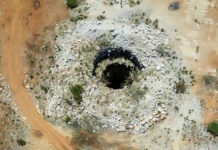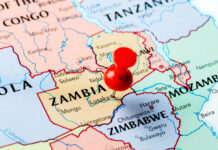
[miningmx.com] — THE likelihood is that Canada’s Barrick Gold will sell its 50% stake in South Deep, the 30 million oz gold resource south-west of Johannesburg. Speculation last week was that Rothschild, a bank which has worked for Barrick in the past, had been retained to enlist offers.
“That would normally come out of our Washington office,’ said Stephen Gorven, corporate finance head for Rothschild in Johannesburg. “I’ll call you back if we’re involved,’ he said in the late afternoon of August 4. This was in response to a Miningmx telephone inquiry that was not finally settled. Yet by August 7, the possibility that Barrick would blow open the ownership of South Deep was gathering pace.
Analysts, and some mining executives, think Barrick will sell. “It’s more than 50% Barrick is a seller,’ said David Davis, Credit Suisse Standard Equities analyst when pressed to decide. “Were I a betting man, they’ll sell,’ said Bernard Swanepoel, Harmony CEO.
Apart from the obvious problems South African mining conditions present to Barrick – labour and depth – there’s also the fact Johannesburg’s South Deep doesn’t fit Barrick’s strategic profile. This profile is to establish clusters of gold mining activities from which the company can derive synergies. In South Africa, Barrick is marooned.
Says Vince Borg, Barrick spokesman: “When we started in Peru, we only had one mine’. That’s true, but no-one seriously expects Barrick to start picking up additional South African assets in order to have its South Deep investment made feasible. And what does it have in South Deep. Reserves, certainly. Big, hairy reserves on which North American analysts place particular emphasis when valuing their gold mining companies.
But South Deep also has its operational difficulties, no clearer illustrated by a shaft accident in May that lopped production at the mine in half for over six months.
South African mining executives are playing cat and mouse. Both Ian Cockerill, Gold Fields CEO and his counterpart at Harmony Gold, Bernard Swanepoel, have expressed a wait and watch approach. Pressed to elaborate, both have forwarded a theoretical, near diffidence that they’d eventually want to own the asset. By interesting contrast, Bobby Godsell, AngloGold Ashanti’s CEO, said he’d be delighted to own South Deep. And the likelihood is that a bidding war will boil down to an AngloGold/Gold Fields duel.
Gold Fields appears best positioned. It has an 18.9% stake in Western Areas, the listed South African company that owns the other (non-controlling) interest in South Deep. Theoretically, this is enough to exert negative control over Harmony Gold’s higher 29.3% stake in Western Areas. For his part, Swanepoel must feel his grip loosening over events. He wants to sell his higher quality mines into Western Areas. But his corporate plans appear to have lost momentum after initially persuading Gill Marcus, Western Areas chairperson, to give mind to his proposal.
It’s thought Marcus was to ask Barrick to waiver its pre-emptive control over Western Areas’s 50% in South Deep, thus paving the way for a Harmony reverse takeover. But the waiver was either turned down or has been left to gather dust.
Sitting in the June heat of Switzerland’s Montreux, Swanepoel told Miningmx he hoped to have clarity on his strategic plans “within days’. Five weeks later, gripped in a Highveld winter, he acknowledges Western Areas might be slipping from his grasp. “It’s going to take much longer to be resolved. It could take two or three years,’ he said.
He earlier expressed his surprise that compatriot gold mining firms were rediscovering an interest in South African mining. But interested they are.
AngloGold Ashanti has courted Barrick. So has Gold Fields. And in preparation for the sale, a number of banks have courted AngloGold and Gold Fields. So in the manner of a grand waltz, which firm has Barrick marked on its card?
AngloGold is stretched financially. It’s also making heavy weather of its last corporate deal, the $1.5bn takeover of Ashanti Goldfields, consummated in 2004. Yet Godsell’s firm might have a better offering were Barrick to seek a neutral value asset swap, giving up reserves in South Africa for reserves elsewhere.
Gold Fields has spending power of note and the ability to accelerate South Deep’s production through Kloof which adjoins South Deep. (Analysts caution, however, not to over-estimate the value of this synergy which could be hampered by a geological fault and water-retaining dolomite that divide the two properties).
JP Morgan analyst, Steve Shepherd, makes the interesting observation that with about R900m in cash as of end-June, Harmony was looking vulnerable again, particularly if losses were to continue at its operations. How much might its initial R1.9bn investment in Western Areas be worth now?
“I don’t have much interest in corporate wars,’ says Swanepoel, possibly ahead of the South African industry’s next pitched battle between South Africa’s gold titans, AngloGold and Gold Fields.











